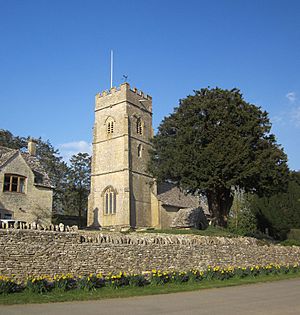Church of St George, Hampnett facts for kids
Quick facts for kids Church of St George |
|
|---|---|
 |
|
| Lua error in Module:Location_map at line 420: attempt to index field 'wikibase' (a nil value). | |
| Denomination | Church of England |
| Architecture | |
| Heritage designation | Grade I listed building |
| Designated | 26 January 1961 |
| Administration | |
| Benefice | Northleach |
| Diocese | Gloucester |
| Province | Canterbury |
The Church of St George is an old church located in Hampnett, a village in the Cotswold District of Gloucestershire, England. It belongs to the Church of England. This church is very important because it is a Grade I listed building, meaning it has special historical and architectural value.
Contents
History of St George's Church
The main parts of the church, called the nave and chancel, were built a very long time ago, around the year 1125. Later, in the 15th century, a tall tower was added to the church.
Art and Restoration
Between 1868 and 1871, a vicar named William Wiggin worked on the church's interior. He wanted to bring back the look of medieval art inside the building. It is thought that a company called Clayton and Bell, known for making beautiful stained glass, might have helped with the paintings.
Church Community
The Church of St George is part of the Northleach group of churches. It is also connected to the wider Diocese of Gloucester, which is a large area managed by the church.
Architecture and Features
The Church of St George is built from limestone and has a roof made of stone slates. It includes a chancel, a nave, and a tower on the west side.
The Tower and Bells
The tower has three levels and holds bells made by a famous bell-making family, Rudhall of Gloucester. These bells have been ringing for many years.
Special Doorway and Font
The north doorway of the nave has a unique design called a Romanesque tympanum. This is a carved or decorated space above the door. Inside, the church has an octagonal font that dates back to the late 15th or early 16th century. The organ in the church was put in place in 1874, replacing an older one.

